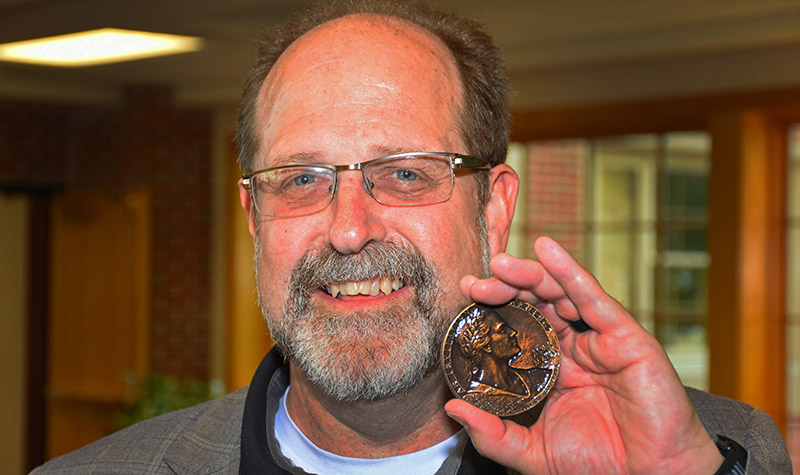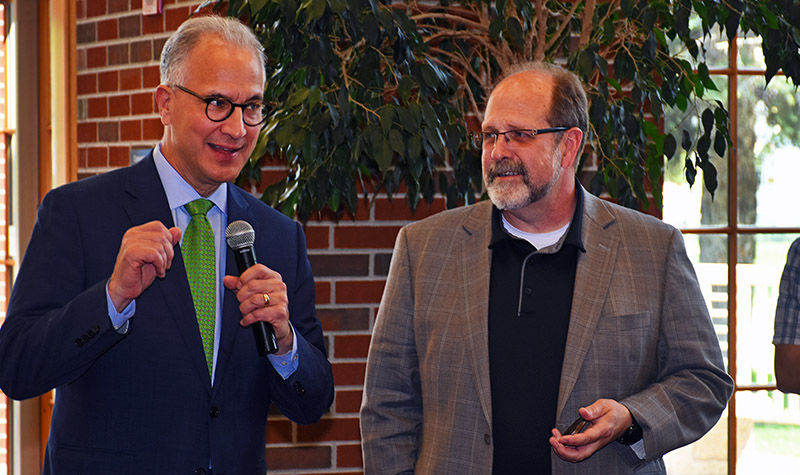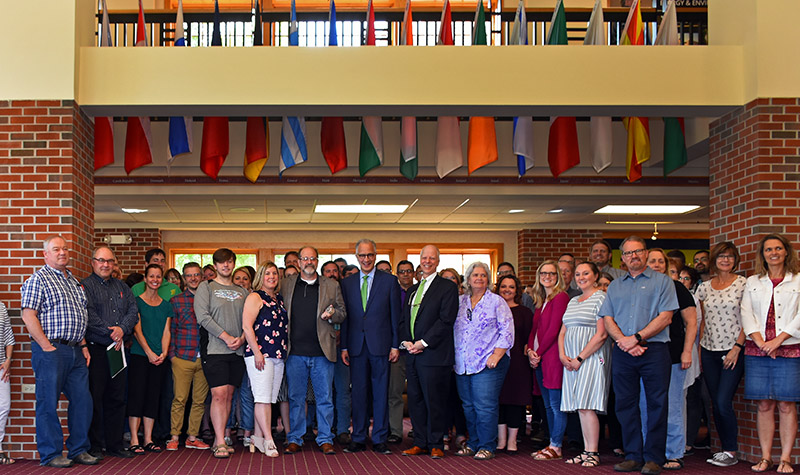05 Jun UND’s EERC Director Tom Erickson receives UND President’s Medal

Tom Erickson, CEO at the UND Energy & Environmental Research Center, shows the Presidential Medal he received Monday from University President Mark Kennedy. Photo by Patrick C. Miller/UND Today.
Energy & Environmental Research Center CEO Tom Erickson on Monday became the 34th person to receive the UND President’s Medal when University President Mark Kennedy made the surprise presentation before employees at the Center.
“I was very surprised and very humbled by the opportunity,” Erickson said after the ceremony. “It’s a tremendous honor, one that I hope I can share in ways with the entire EERC.”
Kennedy cited Erickson’s record of helping the EERC attract millions of dollars annually in government and private research dollars to deal with energy and environmental challenges on the state, national and international levels. He also noted Erickson’s volunteer work with the Community Violence Intervention Center.
“The way that we survive is by writing proposals and doing great world-class research,” Erickson noted. “It takes everyone from our research teams to our support staff to our buildings and grounds folks who keep everything up and operational to make it a success.”

In a surprise ceremony in front of a group of EERC employees, UND President Mark Kennedy cited Erickson’s service to the University and the community while presenting him with the President’s Medal. Photo by Patrick C. Miller/UND Today.
Record of accomplishments
During Erickson’s tenure at the EERC and under his leadership, the Center has:
- Formed the Plains CO2 Reduction Partnership (PCORP) funded by the U.S. Department of Energy, which includes five states, two Canadian provinces and numerous industry partners. For the past 16 years under this program, the EERC has become a leader in carbon capture, utilization and storage technologies. Under PCORP, the ERRC is working with a North Dakota ethanol producer to implement geologic CO2 storage. An EERC project with a North Dakota power plant will capture and store more than 50 million tons of CO2. And the Center has also launched a commercial-scale evaluation of CO2 storage and enhanced oil recovery in the Bakken shale formation. The EERC North Dakota remains the only state granted primacy by the EPA to regulate underground storage of CO2.
- Worked with the oil and gas industry to focus on enhanced oil recovery. In the Bakken shale formation, this has the potential to quadruple the recovery rate of North Dakota’s oil and gas resources. The EERC has also sought to maximize the use of natural gas, the cleanest and most efficient of our fossil fuel resources. Natural gas is also a source of value-added products such as petrochemicals and fertilizers.
- Capitalized on synergies between the agriculture and energy sectors to advance technologies for ethanol and other biofuels. In addition, the EERC has developed agricultural products such as fertilizer from energy production.
- Participated in an innovative consortium to improve pipeline safety, which emerged as a major issue in North Dakota. The EERC is working with the oil and gas industry and the North Dakota Industrial Commission to eliminate pipeline leaks. The Intelligent Pipeline Integrity Program (iPIPE) is exploring emerging technologies to dramatically improve pipeline safety in the state.
- Assisted in enhancing the reliability of the U.S. electrical grid, advancing energy storage systems and increasing pipeline infrastructure. These efforts are reducing the carbon footprint of energy production while helping to boost U.S. energy exports.
- Helped develop the next generation of coal-fired power plants to use North Dakota’s 25 billion tons of recoverable lignite coal resources in the most efficient and environmentally friendly manner possible. The power plant of the future will also be capable of providing rare-earth elements, carbon fiber and other high-value products to make better use of the state’s energy resources.
- Contributed to energy and environmental knowledge worldwide by developing outreach and education tools to better inform the public. At a recent U.S. Senate committee hearing on Capitol Hill, the EERC was singled out by Julio Friedman of the Center for Global Energy for being an exceptional example of building clear, robust and transparent partnerships to engage communities and stakeholders.

Erickson is surrounded by EERC employees and family members during a surprise ceremony at the Center where President Kennedy presented him with the UND President’s medal. Thomas DiLorenzo, UND Vice President for Academic Affairs and Provost, also attended the event. Photo by Patrick C. Miller/UND Today.
Erickson’s bio
Erickson was named CEO of the EERC in October 2014. He leads a multidisciplinary science, engineering, and support team of 220 people who focus on research and development leading to the demonstration and commercialization of innovative energy and environmental technologies.
Beginning as a federal research facility focused on low-rank coal, the EERC has broadened its research scope to include a wide array of strategic energy and environmental issues. Erickson oversees efforts to address these issues through strategic initiatives focused on clean coal technologies, oil and gas industry technologies; carbon capture, utilization, and storage; energy and water sustainability; air toxics and fine particulate control; water management strategies; global climate change; waste utilization, hydrogen technologies; and contaminant cleanup.
Prior to becoming CEO, Erickson served as an EERC associate director for business, operations and Intellectual property where he oversaw activities related to safety, facilities, business functions, and protection and commercialization of intellectual property. He also served as associate director for research, where he developed advanced power and fuel systems from fossil and renewable energy sources.
Erickson holds M.S. and B.S. degrees in chemical engineering from UND. He has authored and coauthored numerous professional publications.
The President’s Medal

The obverse of the President’s Medal.
Kennedy last presented the President’s Medal to Altru Health System CEO Dave Molmen last September for his instrumental role in making the new $124 million UND School of Medicine & Health Sciences a reality.
The President’s Medal was designed by sculptor Avard Fairbanks and embodies the concept of “An Invitation to Learning.” Fairbanks served as sculptor-in-residence at UND in 1966 and earlier created the iconic pioneer family monument that stands today on the State Capitol grounds in Bismarck.
The obverse of the medal bears a head-and-shoulders rendering of Alma Mater, circled by the phrase: “An Invitation to Learning” with an additional inscription that reads “Seek knowledge, gain wisdom, and render love for humanity through greater service.”

Reverse of the President’s Medal
The reverse carries an image of three anonymous people (two males and a female), eyes fixed forward toward a torch, with a heading that reads “University of North Dakota,” circling the top.


